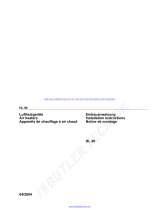
Statutory regulations governing installation Air Top 2000 ST
40
Requirement for basic unit:
A maximum run-on period of 40 seconds is permitted when the combus-
tion heater is switched off. Only combustion heaters with heat exchangers
that are approved for this reduced run-on time of 40 seconds may be used.
1.2. Extract from directive ECE-R 122 Part I and Annex 7
Start of extract.
Part I
5.3 Vehicle Installation Requirements for Combustion Heaters and
for Electric Heaters
5.3.1 Scope
5.3.1.1 Subject to paragraph 5.3.1.2, heaters shall be installed according
to the requirements of paragraph 5.3.
5.3.1.2 Vehicles of category O having liquid fuel heaters are deemed to
comply with the requirements of paragraph 5.3.
5.3.2 Positioning of heater
5.3.2.1 Body sections and any other components in the vicinity of the heat-
er must be protected from excessive heat and the possibility of fuel or oil
contamination.
5.3.2.2 The heater shall not constitute a risk of fire, even in the case of
overheating. This requirement shall be deemed to be met if the installation
ensures an adequate distance to all parts and suitable ventilation, by the
use of fire resistant materials or by the use of heat shields.
5.3.2.3 In the case of M2 and M3 vehicles, the combustion heater must
not be positioned in the passenger compartment. However, an installation
in an effectively sealed envelope which also complies with the conditions
in paragraph 5.3.2.2 may be used.
5.3.2.4 The label referred to in Annex 7, paragraph 4, or a duplicate, must
be positioned so that it can be easily read when the combustion heater is
installed in the vehicle.
5.3.2.5 Every reasonable precaution should be taken in positioning the
heater to minimize the risk of injury and damage to personal property.
5.3.3 Fuel supply
5.3.3.1 The fuel filler must not be situated in the passenger compartment
and must be provided with an effective cap to prevent fuel spillage.
5.3.3.2 In the case of liquid fuel heaters, where a supply separate from that
of the vehicle is provided, the type of fuel and its filler point must be clearly
labelled.
5.3.3.3 A notice, indicating that the heater must be shut down before re-
fuelling, must be affixed to the fuelling point. In addition a suitable instruc-
tion must be included in the manufacturer’s operating manual.
5.3.4 Exhaust system
5.3.4.1 The exhaust outlet must be located so as to prevent emissions from
entering the vehicle through ventilators, heated air inlets or opening win-
dows.
5.3.5 Combustion air inlet
5.3.5.1 The air for the combustion chamber of the heater must not be
drawn from the passenger compartment of the vehicle.
5.3.5.2 The air inlet must be so positioned or guarded that blocking by rub-
bish or luggage is unlikely.
5.3.6 Heating air inlet
5.3.6.1 The heating air supply may be fresh or re-circulated air and must
be drawn from a clean area not likely to be contaminated by exhaust
fumes emitted either by the propulsion engine, the combustion heater or
any other vehicle source.
AT2000ST_Installation_Instructions.book Page 40 Wednesday, May 29, 2013 12:54 PM























